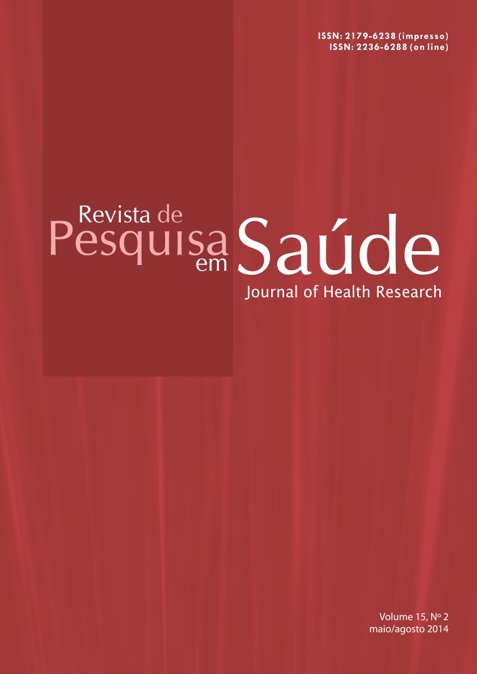EFICÁCIA DE DOIS MÉTODOS DE DEGERMAÇÃO, UTILIZANDO POLIVINILPIRROLIDONA-IODO À 10% / EFFICACY OF TWO-DEGERMATION METHOD, USING POLYVYNYLPIRROLYDONE-IODINE 10%
DOI:
https://doi.org/10.18764/Abstract
Introdução: O procedimento de degermação cirúrgica das mãos e antebraço está incluído no processo de paramentação cirúrgica como medida de prevenção de infecções hospitalares. Com a modernização e maiores estudos, após o advento dos princípios antissépticos degermantes, a necessidade da utilização de escovas vem sendo questionada, devido às lesões que as mesmas podem ocasionar com posterior favorecimento de colonização. Objetivo: Verificar a eficácia de dois métodos de degermação cirúrgica das mãos utilizando polivinilpirrolidona iodo (PVPI à 10%): com escova e sem artefato. Métodos: Trata-se de um estudo experimental. A coleta foi realizada no período de junho a agosto de 2012 no Centro Cirúrgico de um Hospital Universitário em São Luís – MA e analisada no Laboratório de Microbiologia do referido Hospital. A amostra foi de 10 participantes que realizaram as técnicas após explicação e observação do folder ilustrativo. Resultados: Verificou-se que os dois procedimentos de degermação cirúrgica foram eficazes e não houve diferença estatisticamente significante entre os mesmos. Os microrganismos mais frequentes isolados na pele antes e após degermação foram Serratiamarcescens, Staphylococcus aureus, Staphylococcus spp. coagulase negativa. Em menor ocorrência encontrou-se Acinetobacter ursingii e Acinetobacter baumannii. Conclusão:Conclui-se que a redução de microrganismos da pele não está ligada ao uso de artefatos, mas ao tempo que o degermante permanece em contato com a pele associada à fricção utilizando ou não artefatos.
Palavras-chave: Lavagem de mãos. Antissépticos. Infecção Hospitalar.
Abstract
Introduction: The procedure for surgical hand and forearm antisepsis is included in the process of surgical scrub as a measure to prevent nosocomial infections. With the modernization and further studies after the advent of antiseptic principles, the need for the use of brushes has been questioned, due to the injuries they can cause later with favoring colonization. Objective: To determine the effectiveness of two methods of surgical hand antisepsis using polyvinylpyrrolidone iodine (10% PVP): with brush and without artifact. Methods: This is an experimental study. The collection was performed at the Surgery Center of University Hospital in São Luís - MA and analyzed in the Microbiology Laboratory of the aforementioned Hospital. The sample consisted of 10 participants who performed the technical explanation and observation after the illustrative folder. Results: It was demonstrated the efficacy of the two surgical antiseptic procedures and that there was no statistically significant difference between them. The microorganisms most frequent on the skin before and after antisepsis were Serratiamarcescens, Staphylococcus aureus, Staphylococcus spp. coagulase negative. In lower occurrence there were Acinetobacter ursingii and Acinetobacter baumannii. Conclusion: It is concluded that the reduction of microorganisms from the skin is not related to the use of artifacts, but at the time the antiseptics remains in contact with the skin associated with friction using or not artifacts.
Keywords: Hand washing. Antiseptics. Infection.
Downloads
Download data is not yet available.
Downloads
Published
2015-03-11
How to Cite
Bogea, R. L. N., Martins, R. de J. S., Silva, E. L. da, Aquino, D. M. C. de, Lima, W. R. dos S., Marques, S. G., & Azevedo, P. R. (2015). EFICÁCIA DE DOIS MÉTODOS DE DEGERMAÇÃO, UTILIZANDO POLIVINILPIRROLIDONA-IODO À 10% / EFFICACY OF TWO-DEGERMATION METHOD, USING POLYVYNYLPIRROLYDONE-IODINE 10%. Revista De Pesquisa Em Saúde, 15(2). https://doi.org/10.18764/
Issue
Section
Artigos Originais / Original Articles
License
Direitos autorais Revista de Pesquisa em Saúde
Este obra está licenciado com uma Licença Creative Commons Atribuição-NãoComercial-SemDerivações 4.0 Internacional.







